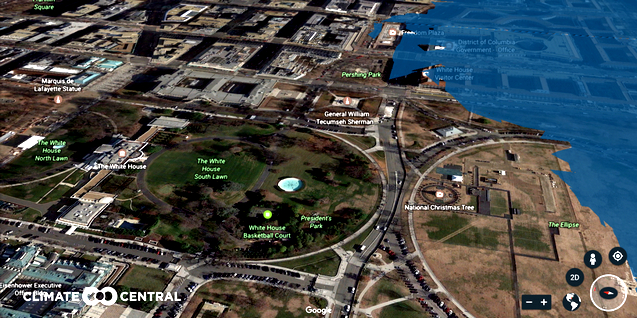 |
| Washington, DC. Google Earth/Climate Central LARGE IMAGE |
Researchers, led by University of Colorado-Boulder professor Steve Nerem, looked at satellite data dating back to 1993 to track the rise of sea levels.
Their findings, published in the journalProceedings of the National Academy of Sciences, show that sea levels aren’t just rising – that rise has been accelerating over the last 25 years.
Even small increases can have devastating consequences, according to climate experts. If the worst climate-change predictions come true, coastal cities in the US will be devastated by flooding and greater exposure to storm surges by the year 2100.
Research group Climate Central has created a plug-in for Google Earth that illustrates how catastrophic an “extreme” sea-level rise scenario would be if the flooding happened today, based on projections in a 2017 report from the National Oceanic and Atmospheric Agency.
You can install the plug-in (directions here) and see what might become of major US cities.
In a worst case scenario, flooding caused by polar melting and
ice-sheet collapses could cause a sea level rise of 10 to 12 feet by
2100, NOAA reported in January 2017.
 |
| The Glacial Ice Sheet, Greenland. Photo: Joe Raedle/ Getty Images LARGE IMAGE |
Here’s Washington, DC today. The famed Potomac River runs through it.
 |
| Google Earth/Climate Central LARGE IMAGE |
And here’s what Washington, DC, might look like in the year 2100 —
as seen on Climate Central’s plug-in for Google Earth. Ocean water
causes the river to overflow.
 |
| Google Earth/Climate Central LARGE IMAGE |
The National Mall drew “the largest audience ever to witness an
inauguration,” at Trump’s swearing-in, according to Press Secretary Sean
Spicer. It sits at the foot of the US Capitol.
 |
| Google Earth/Climate Central LARGE IMAGE |
Future inaugurations wouldn’t quite be the same.
 |
| Google Earth/Climate Central LARGE IMAGE |
In 2017, President Trump stood in the Rose Garden at the White House
and announced his intentions to withdraw from the Paris Agreement, a
deal between 195 countries intended to mitigate global warming.
 |
| Google Earth/Climate Central LARGE IMAGE |
In 2100, the Rose Garden could have an oceanfront view.
 |
| Google Earth/Climate Central LARGE IMAGE |
New York City is situated on one of the world’s largest natural harbours.
 |
| Google Earth/Climate Central LARGE IMAGE |
The Hudson River could flood the city’s perimeters and low-lying areas like the West Village.
 |
| Google Earth/Climate Central LARGE IMAGE |
The Financial District encompasses the offices of many major
financial institutions, including the New York Stock Exchange and the
Federal Reserve Bank of New York.
 |
| Google Earth/Climate Central LARGE IMAGE |
Extreme sea level rise could devastate Wall Street. Battery Park would be a water park.
 |
| Google Earth/Climate Central LARGE IMAGE |
San Francisco has a huge concentration of wealth and power in the technology world.
 |
| Google Earth/Climate Central LARGE IMAGE |
It’s also a peninsula that’s prone to flooding.
 |
| Google Earth/Climate Central LARGE IMAGE |
San Francisco International Airport serves over 53 million travellers every year.
 |
| Google Earth/Climate Central LARGE IMAGE |
In 2100, flyers might have better luck flying into Las Vegas.
 |
| Google Earth/Climate Central LARGE IMAGE |
Charleston, South Carolina, already has a flooding problem. The
Southern city is flat and at low elevation, which makes it vulnerable to
extreme flooding and storm surges.
 |
| Google Earth/Climate Central LARGE IMAGE |
In 2100, you might need a boat to reach the city’s center.
 |
| Google Earth/Climate Central LARGE IMAGE |
Shopping at the Charleston City Market is a must-do for tourists visiting the area.
 |
| Google Earth/Climate Central LARGE IMAGE |
But the long row of red-roofed buildings could be submerged under water by 2100.
 |
| Google Earth/Climate Central LARGE IMAGE |
Los Angeles, which has the third highest elevation of all major US cities, might fare better.
 |
| Google Earth/Climate Central LARGE IMAGE |
The projections show the Pacific Ocean climbing up the boardwalk, but that’s about it.
 |
| Google Earth/Climate Central LARGE IMAGE |
New Orleans is no stranger to the problems that come along with sea level rise.
| Google Earth/Climate Central LARGE IMAGE |
By 2100, The Big Easy could disappear under water. An estimated
500,000 people will have to leave the area in the next century in order
to stay above ground.
 |
| Google Earth/Climate Central LARGE IMAGE |
After flooding caused by Hurricane Katrina destroyed 80% of homes in
the New Orleans area, tens of thousands of people sought refuge at the
Mercedes-Benz Superdome.
 |
| Google Earth/Climate Central LARGE IMAGE |
But the arena used as a “shelter of last resort” might not survive extreme sea level rise.
 |
| Google Earth/Climate Central LARGE IMAGE |
Boston is the only state capital in the continental US that borders
an ocean. Extreme sea level rise could cause the Charles River to
overflow and spill onto city streets.
 |
| Google Earth/Climate Central LARGE IMAGE |
Here’s what Boston might look like in the year 2100. Massachusetts
General Hospital would have to be abandoned, while Boston Public Garden
would be soaked through.
 |
| Google Earth/Climate Central LARGE IMAGE |
Many of the country’s top universities sit along Boston’s Charles River.
 |
| Google Earth/Climate Central LARGE IMAGE |
The education world could say goodbye to the Harvard Business
School, Boston University, Massachusetts Institute of Technology, and
Northeastern University, among others.
 |
| Google Earth/Climate Central LARGE IMAGE |
President Trump has spent a decent part of his presidency in Palm Beach, Florida.
 |
| Google Earth/Climate Central LARGE IMAGE |
He owns the Mar-a-Lago luxury resort and club, better known as the “Winter White House.”
 |
| Google Earth/Climate Central LARGE IMAGE |
If sea levels rose by as much as 12 feet, the Mar-a-Lago estate would not fare well.
 |
| Google Earth/Climate Central LARGE IMAGE |
But Trump will be out of office by the time anything like that happens.
 |
| Google Earth/Climate Central LARGE IMAGE |
- Are The Floating Houses Of The Netherlands A Solution Against The Rising Seas?
- Climate Change Will Almost Certainly Heat The World So Much It Can Never Recover, Major Study Finds
- Satellite Snafu Masked True Sea-Level Rise For Decades
- Earth Could Become ‘Practically Ungovernable’ If Sea Levels Keep Rising, Says Former NASA Climate Chief
- Contributions To Sea-Level Rise Have Increased By Half Since 1993, Largely Because Of Greenland’s Ice
- Scientists Say The Pace Of Sea Level Rise Has Nearly Tripled Since 1990
- Climate Change: Model Predicts Australia To Lose Iconic Sites In New Sea-Level Rise
- 'The Great Unknown': New Climate Change Data Lifts The Sea-Level Threat
- Sea Level Rise Is On The Rise
- As Rising Seas Erode Shorelines, Tasmania Shows What Can Be Lost




